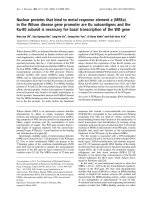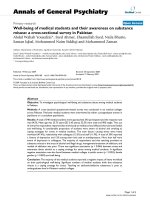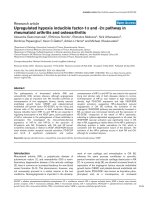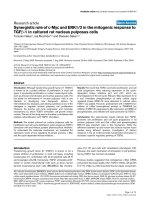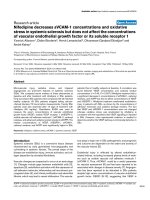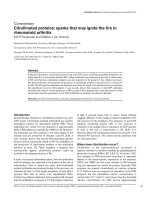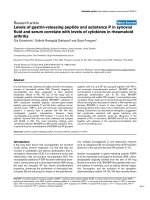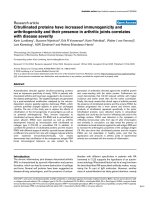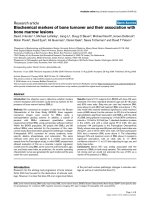Báo cáo y học: "Citrullinated proteins have increased immunogenicity and arthritogenicity and their presence in arthritic joints correlates with disease severity" pdf
Bạn đang xem bản rút gọn của tài liệu. Xem và tải ngay bản đầy đủ của tài liệu tại đây (876.08 KB, 10 trang )
Open Access
Available online />R458
Vol 7 No 3
Research article
Citrullinated proteins have increased immunogenicity and
arthritogenicity and their presence in arthritic joints correlates
with disease severity
Karin Lundberg
1
, Suzanne Nijenhuis
2
, Erik R Vossenaar
2
, Karin Palmblad
1
, Walter J van Venrooij
2
,
Lars Klareskog
1
, AJW Zendman
2
and Helena Erlandsson Harris
1
1
Rheumatology Unit, Department of Medicine, Karolinska Institutet, Stockholm, Sweden
2
Department of Biochemistry, Radboud University Nijmegen, Nijmegen, The Netherlands
Corresponding author: Karin Lundberg,
Received: 21 Oct 2004 Revisions requested: 2 Dec 2004 Revisions received: 16 Dec 2004 Accepted: 20 Jan 2005 Published: 21 Feb 2005
Arthritis Research & Therapy 2005, 7:R458-R467 (DOI 10.1186/ar1697)
/>© 2005 Lundberg et al.; licensee BioMed Central Ltd.
This is an Open Access article distributed under the terms of the Creative Commons Attribution License ( />2.0), which permits unrestricted use, distribution, and reproduction in any medium, provided the original work is properly cited.
Abstract
Autoantibodies directed against citrulline-containing proteins
have an impressive specificity of nearly 100% in patients with
rheumatoid arthritis and have been suggested to be involved in
the disease pathogenesis. The targeted epitopes are generated
by a post-translational modification catalysed by the calcium-
dependent enzyme peptidyl arginine deiminase (PAD), which
converts positively charged arginine to polar but uncharged
citrulline. The aim of this study was to explore the effects of
citrullination on the immunogenicity of autoantigens as well as
on potential arthritogenicity. Thus, immune responses to
citrullinated rat serum albumin (Cit-RSA) and to unmodified rat
serum albumin (RSA) were examined as well as arthritis
development induced by immunisation with citrullinated rat
collagen type II (Cit-CII) or unmodified CII. In addition, to
correlate the presence of citrullinated proteins and the enzyme
PAD4 with different stages of arthritis, synovial tissues obtained
at different time points from rats with collagen-induced arthritis
were examined immunohistochemically. Our results
demonstrate that citrullination of the endogenous antigen RSA
broke immunological tolerance, as was evident by the
generation of antibodies directed against the modified protein
and cross-reacting with the native protein. Furthermore we
could demonstrate that Cit-CII induced arthritis with higher
incidence and earlier onset than did the native counterpart.
Finally, this study reveals that clinical signs of arthritis precede
the presence of citrullinated proteins and the enzyme PAD4. As
disease progressed into a more severe and chronic state,
products of citrullination appeared specifically in the joints.
Citrullinated proteins were detected mainly in extracellular
deposits but could also be found in infiltrating cells and on the
cartilage surface. PAD4 was detected in the cytoplasm of
infiltrating mononuclear cells, from day 21 after immunisation
and onwards. In conclusion, our data reveal the potency of
citrullination to break tolerance against the self antigen RSA and
to increase the arthritogenic properties of the cartilage antigen
CII. We also show that citrullinated proteins and the enzyme
PAD4 are not detectable in healthy joints, and that the
appearance and amounts in arthritic joints of experimental
animals are correlated with the severity of inflammation.
Introduction
The chronic inflammatory joint disease rheumatoid arthritis
(RA) is characterised by synovial inflammation and pannus
formation, which can lead to severe destruction of cartilage
and bone. Several self proteins have been suggested as
disease-driving autoantigens, and the presence of autoan-
tibodies with different specificities in patients with RA
(reviewed in [1,2]) supports the hypothesis of an autoim-
mune aetiology. Rheumatoid factor has for a long time been
the best-described RA-associated antibody marker, recog-
nising the Fc part of IgG molecules. However, another
class of autoantibodies has lately gained attention, namely
Anti-CCP = anti-cyclic citrullinated peptide; anti-MC antibodies = antibodies against chemically modified citrulline; BSA = bovine serum albumin; CIA
= collagen-induced arthritis; CII = collagen type II; Cit-CII = citrullinated CII; Cit-RSA = citrullinated RSA; DA = Dark Agouti; ELISA = enzyme-linked
immunosorbent assay; FIA = Freund's incomplete adjuvant; HRP = horseradish peroxidase; MHC = major histocompatibility complex; PAD = peptidyl
arginine deiminase; PBS = phosphate-buffered saline; RA = rheumatoid arthritis; RSA = rat serum albumin.
Arthritis Research & Therapy Vol 7 No 3 Lundberg et al.
R459
antibodies directed against proteins containing the non-
standard amino acid citrulline [3,4].
Citrulline is generated by the deimination of arginine, a
post-translational modification occurring during apoptosis
as well as during the terminal differentiation of cells, in both
healthy and arthritic individuals [5,6]. Citrullination is cata-
lysed by a family of calcium-dependent enzymes named
peptidyl arginine deiminase (PAD, EC 3.5.3.15) (reviewed
in [7]). These enzymes are present in several different cell
and tissue types, including inflammatory cells (PAD2 [8-10]
and PAD4 [10-12]). PAD4 has been detected in granulo-
cytes infiltrating the synovial tissue in a mouse model of
arthritis [13] and this enzyme, together with PAD2, has also
been demonstrated in macrophages from synovial fluid of
patients with RA [10].
The best-described citrulline-reactive autoantibodies asso-
ciated with RA are the following: anti-perinuclear factor
[14,15] and anti-keratin autoantibodies [16,17], both
directed against citrullinated filaggrin [18]; anti-Sa autoan-
tibodies [19] directed against citrullinated vimentin [20];
and antibodies against cyclic citrullinated peptide (anti-
CCP) [21,22]. These latter autoantibodies have a sensitiv-
ity of up to 80% and a specificity of 98% in patients with
RA [1,22]. Besides this high specificity, these markers are
present early in disease, even before clinical onset [23,24],
and they are synthesised locally by plasma cells in the pan-
nus [25,26]. In addition, the existence of citrulline-reactive
antibodies has been associated with a more active and
severe disease [27-34] and a strong association with major
histocompatibility complex (MHC) shared epitope haplo-
types [28,35,36] has also been reported.
The accumulated data point towards a link between citrull-
inated proteins and the pathogenesis of RA. We therefore
considered it to be of interest to explore the effects of cit-
rullination on the immunogenicity of autoantigens and on
potential arthritogenicity. In the present study we examined
the responses of rat T and B cells to citrullinated rat serum
albumin (Cit-RSA) in comparison with those of unmodified
rat serum albumin (RSA). To investigate the clinical arthri-
togenic relevance of citrullination, the cartilage antigen rat
collagen type II (CII) was modified and arthritis develop-
ment was evaluated in the experimental rat model collagen-
induced arthritis (CIA). In addition, to correlate the pres-
ence of citrullinated proteins with that of PAD4 with differ-
ent stages of arthritis, we examined synovial tissue
immunohistochemically at different time points of CIA.
Our study demonstrates, for the first time, the kinetics of
the presence of citrullinated proteins as well as the enzyme
PAD4 in arthritic joints from experimental animals. The
amounts of citrullinated proteins and the enzyme PAD4 are
correlated with severity of inflammation and are not detect-
able in healthy joints. The study also reveals that the citrull-
ination of proteins can break natural tolerance mechanisms
and increase the arthritogenic properties of CII.
Materials and methods
Animals
Lew.1AV1 and Dark Agouti (DA) rats, originating from the
Zentralinstitut für Versuchstierzucht, Hannover, Germany,
were bred, kept and used under pathogen-free conditions
at the animal department of Karolinska University Hospital,
Stockholm, Sweden. Animals were fed with standard
rodent food and water ad libitum. Experiments were per-
formed with female Lew.1AV1 or male DA rats, aged 9 to
14 weeks, with approval from the Stockholm North Ethical
Committee.
Preparation and citrullination of antigen
CII was prepared from Swarm's rat chondrosarcoma by
pepsin digestion and purification as previously described
[37,38]. CII was stored freeze-dried at -20°C until dis-
solved in 0.01 M acetic acid and dialysed against the cit-
rullination buffer, 0.1 M Tris-HCl (pH 7.6) containing 10
mM CaCl
2
and 5 mM dithiothreitol. RSA (Sigma-Aldrich,
Steinheim, Germany) was dissolved directly in citrullination
buffer. Proteins were incubated with rabbit skeletal muscle
PAD (Sigma), at a concentration of 2 U/mg protein, for 2
hours at 37°C. Citrullination was terminated by adding 20
mM EDTA and subsequently dialysed successively against
2 mM EDTA (pH7.6) and Milli-Q water containing 10 mM
Tris-HCl (pH7.6) at 4°C. Control proteins were treated sim-
ilarly, apart from the addition of PAD. Protein solutions were
then freeze-dried and stored at -20°C. For experimental
use, freeze-dried proteins were dissolved in appropriate
buffer, namely RSA in PBS and CII in 0.01 M acetic acid.
To verify the purity and amount of proteins, aliquots of sam-
ples were run in SDS-PAGE gels followed by Coomassie
Brilliant Blue staining. Total protein quantification was also
performed with a modified version of the Bradford method,
using the Coomassie Plus Protein Assay Reagent Kit
(Pierce Biotechnology, Rockford, IL, USA) in accordance
with the manufacturer's instructions. To verify successful
citrullination, immunoblotting was performed with RA3
[39], a human recombinant antibody directed against citrul-
line (Fig. 1). In brief, 5 µl of citrullinated CII (Cit-CII), CII, Cit-
RSA and RSA (concentration 2 mg/ml) were applied to a
nitrocellulose membrane (BioTrace NT, product no.
66485; Pall Life Sciences, Ann Arbor, MI, USA). The mem-
brane was incubated for 1 hour in blocking buffer (PBS
containing 0.05% Tween 20 with 5% (w/v) non-fat dried
milk) then incubated for a further 1 hour with primary anti-
body RA3, diluted 1:5 in blocking buffer, at room tempera-
ture (20–25°C). After incubation with a horseradish
peroxidase (HRP)-conjugated donkey anti-human antibody
(diluted 1:1,000 in blocking buffer; Amersham Pharmacia
Available online />R460
Biotech, Little Chalfont, Bucks., UK) for 1 hour at room tem-
perature, the protein–antibody complexes were detected
by enhanced chemiluminescence with the ECL system
(Amersham Pharmacia Biotech, Uppsala, Sweden).
Induction and evaluation of clinical disease
To increase the likelihood of detecting citrullinated proteins
and the enzyme PAD4 in the joints of arthritic animals, we
chose to perform the immunohistochemical stainings in the
DA rat, because this strain has proven to develop the most
severe CIA.
In contrast, the Lew.1AV1 rat strain develops a milder dis-
ease and was therefore selected when investigating the
additive arthritogenic effects of Cit-CII. Lew.1AV1 rats
were also used when studying the effects of citrullination
on tolerance to RSA.
Anaesthetised rats were immunised in the base of the tail:
male DA rats with 150 µg of CII dissolved in 100 µl of 0.01
M acetic acid, emulsified with an equal volume of Freund's
incomplete adjuvant (FIA; Difco, Detroit, MI, USA) (intrader-
mally); female Lew.1AV1 rats with 120 µg of CII or Cit-CII
dissolved in 100 µl of 0.01 M acetic acid plus 100 µl of FIA
(intradermally) or with 180 µg of RSA or Cit-RSA dissolved
in 150 µl of PBS plus 150 µl FIA (subcutaneously). The ani-
mals immunised with CII and Cit-CII were monitored for
signs of arthritis from day 12 after immunisation, in accord-
ance with a previously described procedure [40]. Each
paw was divided into three groups of joints, the interphalan-
geal joints of the digits, the metacarpophalangeal and wrist
joints in the forepaws and the metatarsophalangeal and
ankle joints in the hind paws. In brief, 1 point signifies swell-
ing of one group of joints, 2 points signifies two groups of
swollen joints, 3 points signifies three groups of swollen
joints and 4 points signifies swelling of the entire paw. The
maximum score was thus 16 for each rat.
Evaluation of serum anti-RSA and anti-Cit-RSA antibody
levels
Individual serum samples from Lew.1AV1 rats immunised
with RSA and Cit-RSA were obtained at different time
points, namely 12, 24 and 35 days after immunisation (by
tail bleeding) as well as at 61 days after immunisation (by
heart puncture). ELISA plates (96-well Maxisorp; Nunc,
Roskilde, Denmark) were coated with 10 µg/ml RSA or Cit-
RSA (diluted in PBS), overnight at 4°C. Plates were
washed with PBS-Tween (0.05%) and sera (serially diluted
Figure 1
Verification of citrullination of collagen type II (CII) and rat serum albu-min (RSA) by immunoblottingVerification of citrullination of collagen type II (CII) and rat serum albu-
min (RSA) by immunoblotting. Using the recombinant anti-citrullinated
protein antibody RA3, citrulline was detected in the citrullinated CII
(Cit-CII) sample (upper left) as well as in the citrullinated RSA (Cit-
RSA) sample (upper right), while uncitrullinated CII (lower left) and
uncitrullinated RSA (lower right) were negative for citrulline.
Cit-CII Cit-RSA
CII RSA
Figure 2
Citrullinated proteins are present in the arthritic jointCitrullinated proteins are present in the arthritic joint. Positive citrulline
staining was found in extracellular deposits (a,e), cartilage (c) and infil-
trating cells (d). Unimmunised animals were negative for citrulline (f).
Immunohistochemical staining was performed with RA3, a human
recombinant anti-citrullinated protein antibody. Control staining was
performed with an isotyped-matched recombinant human anti-U1-70K
antibody (b). (Original magnifications: ×100 (a,b); ×250 (c); ×400 (d);
×40 (e,f)).
d21p.i.
(a)
d21p.i.
(b)
d21p.i. d21p.i.
(d)(c)
d38p.i. d0p.i.
(f)(e)
Arthritis Research & Therapy Vol 7 No 3 Lundberg et al.
R461
in PBS containing 0.05% Tween) were added in duplicate.
After 2 hours of incubation at room temperature, plates
were washed as above and incubated with alkaline phos-
phatase-conjugated goat anti-rat IgG (diluted 1:5,000 in
PBS containing 0.05% Tween; Jackson Immunoresearch
Lab, West Grove, PA, USA) for a further 2 hours at room
temperature. Finally, a phosphatase substrate (Sigma, St
Louis, MO, USA) was added and absorbance was deter-
mined at 405 nm with an Emax precision microplate reader
(Molecular Devices).
To investigate the risk of contamination by PAD in our Cit-
RSA sample, giving a false positive result in our Cit-RSA
ELISA, we performed an anti-PAD ELISA. Plates were
coated with the same amount of PAD expected to contam-
inate the Cit-RSA sample in the Cit-RSA ELISA, namely
0.0432 µg/ml. The ELISA was performed with the same
procedure as described for Cit-RSA and RSA (see above).
In addition, to quantify antibodies specific for anti-citrulli-
nated protein, an in-house CCP ELISA was used. Control
reactions with corresponding cyclic arginine-containing
peptides were also included. In brief, Streptawell plates
were coated with 1 µg of biotinylated cfc1-cyc citrullinated
peptide or cf0-cyc control peptide (diluted in PBS, 0.1%
BSA) overnight at 4°C. Rat serum samples (diluted 1:50 in
PBS containing 0.05% Tween and 1% BSA) were added
in duplicate and incubated for 1 hour in a 37°C humid
chamber. Plates were washed before the addition of HRP-
conjugated rabbit anti-rat IgG (Sigma P216; diluted
1:1,000 in PBS containing 0.05% Tween and 1% BSA),
followed by incubation for 1 hour in a humid chamber at
37°C. Bound antibodies were revealed by the addition of
3,3',5,5'-tetramethylbenzidine (Sigma). The enzymic reac-
tion was stopped with 0.5 M H
2
SO
4
after 30 min, and
absorbance was determined at 450 nm.
In vitro T cell proliferation in response to stimulation
with RSA and Cit-RSA
Inguinal lymph nodes from Lew.1AV1 rats immunised with
RSA and Cit-RSA were removed 10 days after immunisa-
tion; single-cell suspensions were prepared and resus-
pended in Dulbecco's modified Eagle's medium
supplemented with glutamine, penicillin, streptomycin,
HEPES and 10% fetal calf serum (Life Technologies,
Paisley, Renfrewshire, UK). Cells were cultured in vitro for
72 hours at 10
6
cells per well in triplicate (96-well flat-bot-
tomed culture plates; Nunc) in the presence of RSA (10
µg/ml), Cit-RSA (10 µg/ml), PBS or concanavalin A (2 µg/
ml; Sigma-Aldrich). [
3
H]Thymidine (PerkinElmer Life Sci-
ences Inc., Boston, MA, USA), was added (1 µCi per well)
for the final 16 hours of culture. Cells were harvested with
a Tomtec cell harvester and [
3
H]thymidine incorporation
was measured as counts per minute (c.p.m.) in a Wallac
Trillux 1450 microbeta counter. Stimulation was calculated
and expressed as stimulation index (C.p.m. after stimula-
tion/C.p.m. of background).
Antibodies
Recombinant anti-citrullinated protein single-chain variable
fragment (scFv) antibody RA3, selected from RA-patient-
derived phage display libraries and control scFv human
anti-U1-70K have been described elsewhere [39]. Rabbit
antibodies directed against chemically modified citrulline
(anti-MC antibodies), developed by Dr Tatsuo Senshu and
colleagues [5,41], were purchased from Upstate Biochem-
icals (Lake Placid, NY, USA). Polyclonal antibodies recog-
nising PAD4 (SN823) were produced by immunising
rabbits with PAD4 isotype-specific peptides (amino acids
210 to 225 and 517 to 531) and by affinity purification with
a CNBr-activated Sepharose 4B column, as described pre-
viously [10]. Preimmune rabbit IgG was used as control for
PAD4.
Immunohistochemical analysis
Zamboni-fixed [42] cryopreserved sections of synovial tis-
sue from CII-immunised DA rats were stained for expres-
sion of citrullinated proteins and PAD4. Endogenous
peroxidase activity was blocked by treatment for 30 min in
darkness at room temperature with 1% hydrogen peroxide
and 2% sodium nitride dissolved in PBS. After washing
with PBS, 2% normal goat serum was added to block non-
specific binding sites. Sections were then incubated with
200 µl of primary antibody (RA3 (undiluted) or anti-PAD4
(diluted 1:24)) overnight in a humid chamber at 4°C. An
isotype-matched recombinant human anti-U1-70K anti-
body and a preimmune rabbit IgG were used as respective
controls. Slides were then washed in PBS before incuba-
tion with 200 µl of appropriate biotin-labelled secondary
antibody (donkey anti-human IgG (Jackson Immuno
Research) diluted 1:1,000 or goat anti-rabbit IgG (Vector,
Burlingame, CA, USA) diluted 1:800) for 1 hour at room
temperature. After further washing, 200 µl of avidin-biotin-
HRP (Vectastain; Vector) prepared in accordance with the
manufacturer's directions was applied for 60 min at room
temperature. A final wash was followed by addition of the
substrate diaminobenzidine (Peroxidase Substrate Kit;
Vector) for 5 min. The colour reaction was stopped by
washes in tap water, after which sections were counter-
stained with Mayer's haematoxylin. Finally the slides were
dried and mounted with buffered glycerol, and evaluation
was performed by microscopy with a Polyvar II microscope
(Reichert-Jung, Vienna, Austria) connected to a charge-
coupled device colour camera (DXC-750P; Sony Corp.,
Tokyo, Japan).
In addition, anti-MC antibodies were used to confirm the
citrulline staining obtained with RA3. Before incubation
with primary antibody, sections were treated for 3 hours at
37°C in a chemical modification solution consisting of one
Available online />R462
part solution A (0.025% (w/v) FeCl
3
, 4.6 M H
2
SO
4
, 3.0 M
H
3
PO
4
) plus one part solution B (0.5% diacetyl monoxime,
0.25% antipyrine, 0.5 M acetic acid) (anti-Citrulline (Modi-
fied) Detection Kit; Upstate Biochemicals). Control sec-
tions were incubated in a solution containing one part
solution A and one part Milli-Q water. After extensive wash-
ing in PBS, slides were incubated for 40 min at room tem-
perature with 1% H
2
O
2
, washed in PBS and incubated for
30 min at room temperature with 5% normal goat serum in
PBS plus 1% BSA. Primary antibody (anti-MC), diluted
1:1,000 in PBS plus 1% BSA, was added and slides were
incubated overnight at room temperature. Slides were then
washed in PBS, followed by incubation for 30 min at room
temperature with secondary antibody (biotinylated goat
anti-rabbit IgG; Vector) diluted 1:800 in PBS plus 1%
BSA. The subsequent steps were performed as described
above.
Statistical analysis
All data were evaluated with the Mann–Whitney U-test for
independent groups, except for arthritis incidence, which
was evaluated by Kaplan–Meier survival analysis.
Results
Presence of citrullinated proteins and PAD4 in the
arthritic joints correlates with the degree of
inflammation
To examine the presence of citrullinated proteins and the
enzyme PAD4 in the joints at different stages of experimen-
tal arthritis, histological analyses of rat ankle joints were
performed by immunohistochemistry. Citrullinated proteins
could be detected in the joints of arthritic animals with the
RA3 antibody (Fig. 2 and Table 1). The first appearance of
protein citrullination was noted after disease onset, at day
21 after immunisation, and increased staining was
observed as the disease progressed into a more severe,
Table 1
Correlation of presence of citrullinated proteins and peptidyl arginine deiminase 4 with degree of inflammation
Days after immunisation Arthritis score Cell infiltration Cartilage
destruction
Citrulline-positive
deposits
Citrulline-positive
cells
Citrulline-positive
cartilage
PAD4-positive
cells
0 0.0 0.0 0.0 0.0 0.0 0.0 0.0
3 0.0 0.0 0.0 0.0 0.0 0.0 0.0
6 0.0 0.0 0.0 0.0 0.0 0.0 0.0
10 0.0 0.0 0.0 0.0 0.0 0.0 0.0
15 3.3 ± 2.4 1.3 ± 0.5 0.0 0.0 0.0 0.0 0.0
21 9.8 ± 3.3 1.8 ± 0.5 0.5 ± 0.6 1.0 0.5 ± 0.6 0.8 ± 1.0 1.0 ± 0.5
28 11.0 ± 3.5 3.0 2.5 ± 0.6 1.8 ± 1.0 1.3 ± 0.5 1.5 ± 1.3 1.5 ± 0.4
38 11.8 ± 2.6 3.0 3.0 2.7 ± 0.6 1.8 ± 0.5 0.5 ± 0.6 2.2 ± 0.5
PAD4, peptidyl arginine deiminase 4. Arthritic score, cell infiltration, cartilage destruction and presence of citrullinated proteins in extracellular
deposits, cells and cartilage were evaluated at different time points of collagen-induced arthritis. All data are from four rats, evaluated in a blinded
manner by two independent evaluators and are means ± SD. Arthritis score ranges from 0 to 16 as explained in the Materials and methods section.
Arbitrary units were used for the other features, ranging from 0, indicating no cell infiltration, cartilage destruction, presence of citrullinated proteins
or PAD4, to 3, indicating extensive cell infiltration, cartilage destruction, presence of citrullinated proteins and PAD4.
Figure 3
Peptidyl arginine deiminase 4 (PAD4) is present in the arthritic jointPeptidyl arginine deiminase 4 (PAD4) is present in the arthritic joint.
PAD4 was detected in infiltrating cells (a), localised to the cytoplasm of
mononuclear cells (c,e). Unimmunised animals were negative for PAD4
staining (f). Immunohistochemical stainings were performed with a rab-
bit anti-PAD4 antibody. Control staining was performed with preim-
mune rabbit sera (b,d) (Original magnifications: ×40 (a,b,f); ×200 (c-
e)).
d38p.i.
(a)
d38p.i.
(b)
d28p.i. d28p.i.
(d)(c)
d38p.i.
(e)
d0p.i.
(f)
Arthritis Research & Therapy Vol 7 No 3 Lundberg et al.
R463
chronic state (namely 28 and 38 days after immunisation).
Unimmunised animals and time points before clinical signs
of arthritis (namely 0, 3, 6 and 10 days after immunisation)
as well as the time of disease onset (namely 15 days after
immunisation) were negative for citrulline. Some infiltrating
cells as well as the cartilage surface stained positively for
citrulline and the major sources of citrullinated proteins in
the arthritic joint were extracellular deposits, presumably
fibrin deposits. The occurrence of citrullinated proteins in
the joints is specific, because other investigated organs
such as lung, ear, spinal cord, spleen, lymph nodes and sal-
ivary glands were all negative (data not shown).
For comparison with previous studies in humans [43] and
mice [13] we also used antibodies targeting chemically
modified citrulline. This method circumvents the risk of
epitope blocking by residues flanking citrulline, because
the citrulline side-chain becomes so bulky through the
chemical modification that antibody recognition cannot be
influenced by other amino acids [5,41]. Here we confirmed
the results obtained with RA3. A similar staining pattern
was observed, with positive cells, cartilage and extracellular
deposits, whereas control stainings of non-modified sec-
tions were negative (data not shown).
PAD4, which has been reported to be present in mouse
and human arthritic synovia [10,13], could also be
detected in synovial tissue of this rat arthritis model from 21
days after immunisation (Fig. 3 and Table 1). The number of
positive cells localised to the synovial infiltrate increased by
days 28 and 38 after immunisation. PAD4 was not evident
in healthy synovial tissue, nor in sections from 3, 6 and 10
days after immunisation; although an apparent inflammation
was observed, PAD4 could not be detected 15 days after
immunisation.
Citrullination of a non-immunogenic antigen breaks B
cell tolerance
Lew.1AV1 rats were immunised with the non-immunogenic
autoantigen RSA or the modified counterpart Cit-RSA and
the differences in induced immune responses were ana-
lysed in vitro. The kinetics of the antigen-specific IgG
Figure 4
Immunisation with citrullinated rat serum albumin (Cit-RSA) breaks immunological tolerance on the B cell sideImmunisation with citrullinated rat serum albumin (Cit-RSA) breaks immunological tolerance on the B cell side. Immunisation with Cit-RSA (white
bars) induced an antibody response against Cit-RSA (a), cross-reacting with unmodified rat serum albumin (RSA) (b) at all time points investigated,
whereas immunisation with RSA (black bars) did not. Sera were collected 12, 24, 35 and 61 days after immunisation, and total IgG was measured
by ELISA as OD at 405 nm. Results are means ± SD (n = 7 animals per group), representative of two replicate experiments. **P < 0.01 at all time
points.
0.0
0.2
0.4
0.6
0.8
1.0
1.2
1.4
12 24 35 61
days p.i.
OD (405nm)
0.0
0.2
0.4
0.6
0.8
1.0
1.2
1.4
12 24 35 61
days p.i.
OD (405nm )
Anti-Cit-RSA IgG Anti-RSA IgG
Cit-RSA-im.
RSA-im.
Cit-RSA-im.
RSA-im.
(a) (b)
Figure 5
In vitro proliferative responses to rat serum albumin (RSA) and to citrull-inated RSA (Cit-RSA)In vitro proliferative responses to rat serum albumin (RSA) and to citrull-
inated RSA (Cit-RSA). Stronger T cell responses to Cit-RSA (statisti-
cally significant) and to RSA (a trend) were observed in animals
immunised with Cit-RSA (white bars) than in animals immunised with
unmodified RSA (black bars). As previously shown (Fig. 4), the animals
immunised with Cit-RSA developed a B cell response to RSA and to
Cit-RSA, whereas the animals immunised with RSA did not. The dotted
line suggests a hypothetical threshold that it is necessary to reach to
induce B cell help and subsequent antibody production. Single cell
suspensions were prepared from inguinal lymph nodes 10 days after
immunisation, and stimulation index (S.I.) was calculated after 72 hours
of culture in the presence of RSA or Cit-RSA (10 µg/ml). Results are
means ± SD (n = 7 animals per group), representative of two replicate
experiments. *P < 0.05.
0.0
1.0
2.0
3.0
4.0
5.0
6.0
RSA-stim Cit-RSA-stim
S.I.
*
Cit-RSA-im.
RSA-im.
Available online />R464
response was investigated and the results revealed not
only a response towards the modified protein, but also
cross-reactivity to the unmodified form of RSA (Fig. 4). Anti-
bodies were detected from 12 days after immunisation, had
increased by day 24 after immunisation and persisted for a
further 40 days. Cross-reactivity was demonstrated at all
time points. No B cell response was noted in animals immu-
nised with unmodified RSA.
Animals immunised with Cit-RSA and RSA were also
tested for anti-PAD IgG responses. The anti-PAD ELISA
was negative both for animals immunised with Cit-RSA and
for animals immunised with RSA (data not shown),
indicating that the amount of PAD contaminating the Cit-
RSA sample did not result in any false positive result in the
Cit-RSA ELISA, described above.
In addition, by performing both an anti-CCP ELISA and a
control ELISA containing cyclic arginine-containing pep-
tides, we could confirm that the animals immunised with
Cit-RSA produced antibodies against citrullinated epitopes
and also antibodies recognising arginine epitopes (data not
shown).
The T cell response was evaluated by [
3
H]thymidine incor-
poration 10 days after immunisation, as depicted in Fig. 5.
Here, a proliferative response was demonstrated in animals
immunised with unmodified RSA, both when stimulated
with the same antigen and when stimulated with the citrull-
inated antigen. Cells from animals immunised with Cit-RSA
showed a stronger proliferation than the RSA-immunised
rats in response to the modified protein. The same ten-
dency was observed when using RSA as a stimulus,
although it was not statistically significant.
Immunisation with Cit-CII increases arthritis incidence
and accelerates clinical onset of disease
Unmodified or citrullinated rat CII was, together with adju-
vant, injected into Lew.1AV1 rats; arthritis development
was monitored by blinded macroscopic evaluation. The cit-
rullinated form of CII induced arthritis with significantly
higher incidence and earlier onset than did the same
amount of unmodified CII (Fig. 6). The incidence was 35%
higher in the Cit-RSA group during the early phase of the
disease and 15% higher during the end stage. Disease
onset in this group occurred 13 days after immunisation,
compared with 16 days after immunisation in the control
group. A trend towards higher mean arthritis score was
also observed in the affected animals in the Cit-CII group
compared with the CII group, although this was not statis-
tically significant.
Discussion
The production of anti-citrullinated protein antibodies is
almost 100% specific for patients with RA, indicating an
important role for citrullinated proteins in the pathogenesis
of RA. We therefore considered it of interest to investigate
the ability to break immunological tolerance by the citrulli-
nation of endogenous proteins. Our data reveal that citrull-
ination of the non-immunogenic antigen RSA induced an
antibody response against the citrullinated protein with
cross-reactivity to the unmodified protein at all time points
investigated. The observation that anti-RSA IgG titres
declined by 61 days after immunisation, as opposed to anti-
cit-RSA IgG titres, might be due to affinity maturation of the
B cell response with bias towards the citrullinated
'neoepitope'. Another possibility could be the formation of
RSA antibodies and RSA immune complexes, which would
increase their clearance from the circulation.
We could record an ex vivo proliferative T cell response to
RSA as well as to Cit-RSA in rats immunised with modified
protein and also in rats immunised with the unmodified pro-
Figure 6
Citrullination of collagen type II (CII) increases its arthritogenic propertiesCitrullination of collagen type II (CII) increases its arthritogenic properties. Lew.1AV1 rats developed disease with higher incidence (a) and earlier
onset as well as a trend towards higher mean arthritic score among the affected animals (b) when immunised with citrullinated CII (Cit-CII) (open
squares) than when immunised with unmodified CII (filled circles). Rats were immunised with Cit-CII or unmodified CII and monitored for signs of
arthritis for the next 30 days. Incidence (a) and mean score of sick animals (b) were calculated. Data include 20 animals per group from two pooled
experiments. *P < 0.05.
0
10
20
30
40
50
60
70
80
90
100
0 5 10 15 20 25 30
Days p.i.
Incidence (%)
Cit-CII-im.
CII-im.
0
1
2
3
4
5
6
0 5 10 15 20 25 30
Days p.i.
Mean score, sick animals
*
*
*
*
Cit-CII-im.
CII-im.
(a) (b)
Arthritis Research & Therapy Vol 7 No 3 Lundberg et al.
R465
tein, as demonstrated by stimulation index values over 1.0.
When comparing the proliferative responses to Cit-RSA,
cells from animals immunised with the citrullinated protein
demonstrated a significantly stronger response than cells
from animals immunised with the unmodified protein (P <
0.05). A similar trend was detected when comparing the
responses of T cells to RSA, but the difference did not
reach statistical significance. This indicates that RSA,
together with a strong adjuvant, can induce an autoreactive
T cell response, although this is not sufficient to induce B
cell help. In contrast, immunisation with Cit-RSA induced a
stronger T cell response that could confer B cell help, as
depicted in Fig. 4.
Furthermore, Cit-CII induced arthritis with earlier onset and
higher incidence than unmodified CII after immunisation.
Considering the low arginine content of CII, our results indi-
cate that protein modification by the conversion of arginine
to citrulline is a highly potent mechanism for increased
autoreactivity. Previous studies have demonstrated that
anti-CII antibody titres do not reflect disease severity in this
model of CIA and that stimulation in vitro with homologous
CII does not induce T cell proliferation. We therefore chose
not to analyse the humoral or cellular responses to CII in
these animals.
Several post-translational protein modifications, especially
those related to apoptosis [44,45], are associated with
autoimmunity [46-49]. Inefficient clearance of these modi-
fied proteins in an inflammatory environment, conveying
'danger signals' to the immune system, might in combina-
tion with the appropriate MHC haplotype override toler-
ance mechanisms and activate autoreactive T cells.
Citrullination interferes with organised protein structure,
contributes to protein unfolding and to increased suscepti-
bility to digesting enzymes [50,51], which could lead to
altered antigen uptake, processing and presentation.
Indeed, citrullinated peptides have been reported to bind
more efficiently to the RA-associated HLA-DRB1*0401
haplotype than do non-citrullinated peptides [52]. As toler-
ance has not been established to such peripherally modi-
fied self-peptides, citrullination might increase the risk of
activating pathogenic T cells. Our data therefore demon-
strate not only the potency of citrullinated proteins to break
tolerance, as evident from our experiments with RSA, but
also the increased arthritogenic properties of Cit-CII.
Because anti-citrullinated protein antibodies can be
detected in RA sera before clinical signs of disease [24],
we speculate that citrullination of synovial proteins might
occur at time points before RA becomes manifest. It is not
ethically possible to examine the synovial tissue of healthy
individuals at risk of developing RA. However, this
becomes feasible with the use of an experimental model. In
the present study we examined, for the first time, the kinet-
ics of the presence of citrullinated proteins and the citrulli-
nating enzyme PAD4 in joints during arthritis development.
In this experimental model of homologous CIA with 100%
disease incidence, citrullinated proteins and PAD4 were
not detectable before clinical signs of arthritis. Rather, as
inflammation proceeded, increasing amounts of citrulli-
nated proteins and PAD4 were detected specifically in the
joints. Extracellular deposits constitute the major source of
citrullinated proteins in the inflamed joint, although both
cells and cartilage also contribute to the positive staining.
Although PAD4 has been described to have a nuclear
localisation [12], our stainings clearly demonstrate the
presence of this enzyme in the cytoplasm of infiltrating
mononuclear cells. Our inability to detect nuclear staining
of PAD4 might be due to the absence of permeabilising
agents during staining procedures. Our finding that citrulli-
nated synovial proteins could not be encountered before
disease onset might explain the failure in detecting anti-cit-
rullinated protein antibodies in animal models. Perhaps the
presence of citrullinated proteins in these arthritis models
is not disease-initiating, but rather a result of inflammation.
This is also supported by the observation that citrullinated
proteins can be detected in inflamed synovial tissue of non-
RA patients lacking the anti-citrulline-specific B cell
response [53,54].
Taking together our findings and those of others, we
hypothesise that in individuals with the appropriate genetic
background a subclinical inflammation that induces citrulli-
nation of endogenous proteins will generate a pathogenic
immune response against the modified proteins and that
through the production of autoantibodies a chronic inflam-
mation will be established. An immune response towards
any citrullinated protein is clearly not enough to induce
clinical arthritis, as demonstrated by the lack of signs of dis-
ease in the Cit-RSA-immunised animals. Both genetic and
environmental factors most probably contribute to the
development of arthritis. The initiation of citrulline reactivity
does not necessarily need to occur in the joints. For exam-
ple, smoking has been reported to be an environmental risk
factor for RA in individuals with MHC shared epitope [55].
It is plausible that smoking could induce such an inflamma-
tory reaction in lungs with the formation of citrullinated pro-
teins. Why an autoreactivity to citrullinated proteins would
precipitate in arthritis and not in other organ-specific inflam-
matory diseases is currently unknown. However, several
reports indicate that joints are especially sensitive to inflam-
matory stimuli. The experimental model oil-induced arthritis
demonstrates that administration of the non-antigenic adju-
vant mineral oil at a distant location (namely the tail base)
induces arthritis and no other disease in rats [56]. Addition-
ally, systemic overexpression of proinflammatory cytokine
TNF generates a joint-specific inflammation [57]. Similarly,
interleukin-1Ra knockout mice develop arthritis [58].
Available online />R466
Conclusion
Our data reveal the potency of citrullination to break toler-
ance against the ubiquitous systemic self antigen RSA and
to increase the arthritogenicity of the tissue-specific protein
CII. Furthermore, we have demonstrated that the amounts
of citrullinated proteins and the enzyme PAD4 in the
arthritic joints of experimental animals correlated with the
severity of inflammation, while no citrullinated proteins or
PAD4 could be detected in healthy joints. On the basis of
our new data and previous findings on this topic we hypoth-
esise that a subclinical inflammation might induce citrullina-
tion of endogenous proteins. This citrullination does not
necessarily need to occur in joints but can occur elsewhere
in the body. In combination with a certain genetic context,
anti-citrullinated protein antibodies will be generated,
which will potentiate an inflammatory trigger in joints and
thereby initiate RA.
Competing interests
The author(s) declare that they have no competing
interests.
Authors' contributions
KL was responsible for most of the experiments and data
analysis as well as drafting the manuscript. HEH, together
with KL, was responsible for study design coordination and
compilation of the manuscript. SN and ERV performed the
citrullination of proteins and the production of antibodies
(RA3, anti-U1-70K, anti-PAD4 and preimmune rabbit sera).
KP performed the immunisation, scoring and sectioning of
rat ankle joints of the DA rats. WJV, LK and AJWZ contrib-
uted to interpretation and discussion of data. All authors
read and approved the final manuscript.
Acknowledgements
The authors thank Kalok Cheung for performing the CCP ELISA and
Associate Professor Robert A Harris for linguistic advice. This work was
supported by grants from the Swedish Science council, the Swedish
Association Against Rheumatism, the Foundation of King Gustav V, the
Börje Dahlin Foundation, the Nanna Svartz Foundation, the Af Ugglas
Foundation, the Netherlands Foundation for Chemical Research and the
Netherlands Technology Foundation (grant 349–5077), Het Nationaal
Reumafonds of The Netherlands (The Dutch League against Rheuma-
tism, grant 00-2-402) and the Netherlands Foundation for Medical
Research (NOW grant 940-35-037).
References
1. van Boekel MA, Vossenaar ER, van den Hoogen FH, van Venrooij
WJ: Autoantibody systems in rheumatoid arthritis: specificity,
sensitivity and diagnostic value. Arthritis Res 2002, 4:87-93.
2. Steiner G, Smolen J: Autoantibodies in rheumatoid arthritis and
their clinical significance. Arthritis Res 2002, 4(Suppl 2):S1-S5.
3. Schellekens GA, de Jong BA, van den Hoogen FH, van de Putte
LB, van Venrooij WJ: Citrulline is an essential constituent of
antigenic determinants recognized by rheumatoid arthritis-
specific autoantibodies. J Clin Invest 1998, 101:273-281.
4. Girbal-Neuhauser E, Durieux JJ, Arnaud M, Dalbon P, Sebbag M,
Vincent C, Simon M, Senshu T, Masson-Bessiere C, Jolivet-Rey-
naud C, et al.: The epitopes targeted by the rheumatoid arthri-
tis-associated antifilaggrin autoantibodies are
posttranslationally generated on various sites of (pro)filaggrin
by deimination of arginine residues. J Immunol 1999,
162:585-594.
5. Senshu T, Akiyama K, Kan S, Asaga H, Ishigami A, Manabe M:
Detection of deiminated proteins in rat skin: probing with a
monospecific antibody after modification of citrulline residues.
J Invest Dermatol 1995, 105:163-169.
6. Senshu T, Kan S, Ogawa H, Manabe M, Asaga H: Preferential
deimination of keratin K1 and filaggrin during the terminal dif-
ferentiation of human epidermis. Biochem Biophys Res
Commun 1996, 225:712-719.
7. Vossenaar ER, Zendman AJ, van Venrooij WJ, Pruijn GJ: PAD, a
growing family of citrullinating enzymes: genes, features and
involvement in disease. BioEssays 2003, 25:1106-1118.
8. Watanabe K, Akiyama K, Hikichi K, Ohtsuka R, Okuyama A, Sen-
shu T: Combined biochemical and immunochemical compari-
son of peptidylarginine deiminases present in various tissues.
Biochim Biophys Acta 1988, 966:375-383.
9. Nagata S, Senshu T: Peptidylarginine deiminase in rat and
mouse hemopoietic cells. Experientia 1990, 46:72-74.
10. Vossenaar ER, Radstake TR, Van Der Heijden A, Van Mansum MA,
Dieteren C, De Rooij DJ, Barrera P, Zendman AJ, Van Venrooij WJ:
Expression and activity of citrullinating peptidylarginine deim-
inase enzymes in monocytes and macrophages. Ann Rheum
Dis 2004, 63:373-381.
11. Asaga H, Nakashima K, Senshu T, Ishigami A, Yamada M: Immu-
nocytochemical localization of peptidylarginine deiminase in
human eosinophils and neutrophils. J Leukoc Biol 2001,
70:46-51.
12. Nakashima K, Hagiwara T, Yamada M: Nuclear localization of
peptidylarginine deiminase V and histone deimination in
granulocytes. J Biol Chem 2002, 277:49562-49568.
13. Vossenaar ER, Nijenhuis S, Helsen MM, van der Heijden A, Sen-
shu T, van den Berg WB, van Venrooij WJ, Joosten LA: Citrullina-
tion of synovial proteins in murine models of rheumatoid
arthritis. Arthritis Rheum 2003, 48:2489-2500.
14. Hoet RM, Boerbooms AM, Arends M, Ruiter DJ, van Venrooij WJ:
Antiperinuclear factor, a marker autoantibody for rheumatoid
arthritis: colocalisation of the perinuclear factor and
profilaggrin. Ann Rheum Dis 1991, 50:611-618.
15. Nienhuis RL, Mandema E: A new serum factor in patients with
rheumatoid arthritis; the antiperinuclear factor. Ann Rheum Dis
1964, 23:302-305.
16. Simon M, Girbal E, Sebbag M, Gomes-Daudrix V, Vincent C,
Salama G, Serre G: The cytokeratin filament-aggregating pro-
tein filaggrin is the target of the so-called 'antikeratin antibod-
ies,' autoantibodies specific for rheumatoid arthritis. J Clin
Invest 1993, 92:1387-1393.
17. Young BJ, Mallya RK, Leslie RD, Clark CJ, Hamblin TJ: Anti-kera-
tin antibodies in rheumatoid arthritis. Br Med J 1979, 2:97-99.
18. Sebbag M, Simon M, Vincent C, Masson-Bessiere C, Girbal E,
Durieux JJ, Serre G: The antiperinuclear factor and the so-called
antikeratin antibodies are the same rheumatoid arthritis-spe-
cific autoantibodies. J Clin Invest 1995, 95:2672-2679.
19. Despres N, Boire G, Lopez-Longo FJ, Menard HA: The Sa sys-
tem: a novel antigen-antibody system specific for rheumatoid
arthritis. J Rheumatol 1994, 21:1027-1033.
20. Vossenaar ER, Despres N, Lapointe E, Van Der Heijden A, Lora M,
Senshu T, Van Venrooij WJ, Menard HA: Rheumatoid arthritis
specific anti-Sa antibodies target citrullinated vimentin. Arthri-
tis Res Ther 2004, 6:R142-R150.
21. Schellekens GA, Visser H, de Jong BA, van den Hoogen FH,
Hazes JM, Breedveld FC, van Venrooij WJ: The diagnostic prop-
erties of rheumatoid arthritis antibodies recognizing a cyclic
citrullinated peptide. Arthritis Rheum 2000, 43:155-163.
22. van Venrooij WJ, Hazes JM, Visser H: Anticitrullinated protein/
peptide antibody and its role in the diagnosis and prognosis of
early rheumatoid arthritis. Neth J Med 2002, 60:383-388.
23. Kurki P, Aho K, Palosuo T, Heliovaara M: Immunopathology of
rheumatoid arthritis. Antikeratin antibodies precede the clini-
cal disease. Arthritis Rheum 1992, 35:914-917.
24. Rantapaa-Dahlqvist S, de Jong BA, Berglin E, Hallmans G, Wadell
G, Stenlund H, Sundin U, van Venrooij WJ: Antibodies against
cyclic citrullinated peptide and IgA rheumatoid factor predict
the development of rheumatoid arthritis. Arthritis Rheum 2003,
48:2741-2749.
Arthritis Research & Therapy Vol 7 No 3 Lundberg et al.
R467
25. Masson-Bessiere C, Sebbag M, Durieux JJ, Nogueira L, Vincent C,
Girbal-Neuhauser E, Durroux R, Cantagrel A, Serre G: In the rheu-
matoid pannus, anti-filaggrin autoantibodies are produced by
local plasma cells and constitute a higher proportion of IgG
than in synovial fluid and serum. Clin Exp Immunol 2000,
119:544-552.
26. Reparon-Schuijt CC, van Esch WJ, van Kooten C, Schellekens
GA, de Jong BA, van Venrooij WJ, Breedveld FC, Verweij CL:
Secretion of anti-citrulline-containing peptide antibody by B
lymphocytes in rheumatoid arthritis. Arthritis Rheum 2001,
44:41-47.
27. Kirstein H, Mathiesen FK: Antikeratin antibodies in rheumatoid
arthritis. Methods and clinical significance. Scand J Rheumatol
1987, 16:331-338.
28. Bas S, Perneger TV, Mikhnevitch E, Seitz M, Tiercy JM, Roux-Lom-
bard P, Guerne PA: Association of rheumatoid factors and anti-
filaggrin antibodies with severity of erosions in rheumatoid
arthritis. Rheumatology (Oxford) 2000, 39:1082-1088.
29. Paimela L, Gripenberg M, Kurki P, Leirisalo-Repo M: Antikeratin
antibodies: diagnostic and prognostic markers for early rheu-
matoid arthritis. Ann Rheum Dis 1992, 51:743-746.
30. Paimela L, Palosuo T, Aho K, Lukka M, Kurki P, Leirisalo-Repo M,
von Essen R: Association of autoantibodies to filaggrin with an
active disease in early rheumatoid arthritis. Ann Rheum Dis
2001, 60:32-35.
31. Forslin K, Vincent C, Serre G, Svensson B: Antifilaggrin antibod-
ies in early rheumatoid arthritis may predict radiological
progression. Scand J Rheumatol 2001, 30:221-224.
32. van Jaarsveld CH, ter Borg EJ, Jacobs JW, Schellekens GA,
Gmelig-Meyling FH, van Booma-Frankfort C, de Jong BA, van Ven-
rooij WJ, Bijlsma JW: The prognostic value of the antiperinu-
clear factor, anti-citrullinated peptide antibodies and
rheumatoid factor in early rheumatoid arthritis. Clin Exp
Rheumatol 1999, 17:689-697.
33. Vencovsky J, Machacek S, Sedova L, Kafkova J, Gatterova J, Pesa-
kova V, Ruzickova S: Autoantibodies can be prognostic markers
of an erosive disease in early rheumatoid arthritis. Ann Rheum
Dis 2003, 62:427-430.
34. Meyer O, Labarre C, Dougados M, Goupille P, Cantagrel A,
Dubois A, Nicaise-Roland P, Sibilia J, Combe B: Anticitrullinated
protein/peptide antibody assays in early rheumatoid arthritis
for predicting five year radiographic damage. Ann Rheum Dis
2003, 62:120-126.
35. Goldbach-Mansky R, Lee J, McCoy A, Hoxworth J, Yarboro C,
Smolen JS, Steiner G, Rosen A, Zhang C, Menard HA, et al.:
Rheumatoid arthritis associated autoantibodies in patients
with synovitis of recent onset. Arthritis Res 2000, 2:236-243.
36. van Gaalen FA, van Aken J, Huizinga TW, Schreuder GM, Breed-
veld FC, Zanelli E, van Venrooij WJ, Verweij CL, Toes RE, deVries
RR: Association between HLA class II genes and autoantibod-
ies to cyclic citrullinated peptides (CCPs) influences the sever-
ity of rheumatoid arthritis. Arthritis Rheum 2004, 50:2113-2121.
37. Miller EJ: Structural studies on cartilage collagen employing
limited cleavage and solubilization with pepsin. Biochemistry
1972, 11:4903-4909.
38. Andersson M, Holmdahl R: Analysis of type II collagen-reactive
T cells in the mouse. I. Different regulation of autoreactive vs.
non-autoreactive anti-type II collagen T cells in the DBA/1
mouse. Eur J Immunol 1990, 20:1061-1066.
39. Raats JM, Wijnen EM, Pruijn GJ, van den Hoogen FH, van Venrooij
WJ: Recombinant human monoclonal autoantibodies specific
for citrulline-containing peptides from phage display libraries
derived from patients with rheumatoid arthritis. J Rheumatol
2003, 30:1696-1711.
40. Åkerlund K, Erlandsson Harris H, Tracey KJ, Wang H, Fehniger T,
Klareskog L, Andersson J, Andersson U: Anti-inflammatory
effects of a new tumour necrosis factor-alpha (TNF-alpha)
inhibitor (CNI-1493) in collagen-induced arthritis (CIA) in rats.
Clin Exp Immunol 1999, 115:32-41.
41. Senshu T, Sato T, Inoue T, Akiyama K, Asaga H: Detection of cit-
rulline residues in deiminated proteins on polyvinylidene diflu-
oride membrane. Anal Biochem 1992, 203:94-100.
42. Ahmed M, Bjurholm A, Schultzberg M, Theodorsson E, Kreicbergs
A: Increased levels of substance P and calcitonin gene-related
peptide in rat adjuvant arthritis. A combined immunohisto-
chemical and radioimmunoassay analysis. Arthritis Rheum
1995, 38:699-709.
43. Masson-Bessiere C, Sebbag M, Girbal-Neuhauser E, Nogueira L,
Vincent C, Senshu T, Serre G: The major synovial targets of the
rheumatoid arthritis-specific antifilaggrin autoantibodies are
deiminated forms of the alpha- and beta-chains of fibrin. J
Immunol 2001, 166:4177-4184.
44. Doyle HA, Mamula MJ: Posttranslational protein modifications:
new flavors in the menu of autoantigens. Curr Opin Rheumatol
2002, 14:244-249.
45. Utz PJ, Gensler TJ, Anderson P: Death, autoantigen modifica-
tions, and tolerance. Arthritis Res 2000, 2:101-114.
46. Arentz-Hansen H, Korner R, Molberg O, Quarsten H, Vader W,
Kooy YM, Lundin KE, Koning F, Roepstorff P, Sollid LM, et al.: The
intestinal T cell response to alpha-gliadin in adult celiac dis-
ease is focused on a single deamidated glutamine targeted by
tissue transglutaminase. J Exp Med 2000, 191:603-612.
47. Neugebauer KM, Merrill JT, Wener MH, Lahita RG, Roth MB: SR
proteins are autoantigens in patients with systemic lupus ery-
thematosus. Importance of phosphoepitopes. Arthritis Rheum
2000, 43:1768-1778.
48. Zamvil SS, Mitchell DJ, Moore AC, Kitamura K, Steinman L, Roth-
bard JB: T-cell epitope of the autoantigen myelin basic protein
that induces encephalomyelitis. Nature 1986, 324:258-260.
49. Andrade F, Casciola-Rosen L, Rosen A: Apoptosis in systemic
lupus erythematosus. Clinical implications. Rheum Dis Clin
North Am 2000, 26:215-227.
50. Tarcsa E, Marekov LN, Mei G, Melino G, Lee SC, Steinert PM: Pro-
tein unfolding by peptidylarginine deiminase. Substrate spe-
cificity and structural relationships of the natural substrates
trichohyalin and filaggrin. J Biol Chem 1996,
271:30709-30716.
51. Lamensa JW, Moscarello MA: Deimination of human myelin
basic protein by a peptidylarginine deiminase from bovine
brain. J Neurochem 1993, 61:987-996.
52. Hill JA, Southwood S, Sette A, Jevnikar AM, Bell DA, Cairns E:
Cutting edge: the conversion of arginine to citrulline allows for
a high-affinity peptide interaction with the rheumatoid arthri-
tis-associated HLA-DRB1*0401 MHC class II molecule. J
Immunol 2003, 171:538-541.
53. Chapuy-Regaud S, Sebbag M, Baeten D, Clavel C, De Keyser F,
Serre G: The presence of deiminated fibrin in the synovial
membrane is not specific for rheumatoid arthritis. Arthritis Res
Ther 2004, 6(Suppl 1):20.
54. Vossenaar ER, Smeets TJ, Kraan MC, Raats JM, Van Venrooij WJ,
Tak PP: The presence of citrullinated proteins is not specific
for rheumatoid synovial tissue. Arthritis Rheum 2004,
50:3485-3494.
55. Padyukov L, Silva C, Stolt P, Alfredsson L, Klareskog L: A gene-
environment interaction between smoking and shared epitope
genes in HLA-DR provides a high risk of seropositive rheuma-
toid arthritis. Arthritis Rheum 2004, 50:3085-3092.
56. Kleinau S, Erlandsson H, Holmdahl R, Klareskog L: Adjuvant oils
induce arthritis in the DA rat. I. Characterization of the disease
and evidence for an immunological involvement. J Autoimmun
1991, 4:871-880.
57. Butler DM, Malfait AM, Mason LJ, Warden PJ, Kollias G, Maini RN,
Feldmann M, Brennan FM: DBA/1 mice expressing the human
TNF-alpha transgene develop a severe, erosive arthritis: char-
acterization of the cytokine cascade and cellular composition.
J Immunol 1997, 159:2867-2876.
58. Horai R, Saijo S, Tanioka H, Nakae S, Sudo K, Okahara A, Ikuse T,
Asano M, Iwakura Y: Development of chronic inflammatory
arthropathy resembling rheumatoid arthritis in interleukin 1
receptor antagonist-deficient mice. J Exp Med 2000,
191:313-320.

